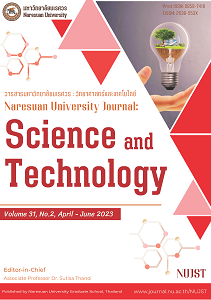Distinct 3-dimensional features of immature and mature dendritic cells
DOI:
https://doi.org/10.14456/nujst.2023.19Keywords:
dendritic cells, 3-D image, holotomographyAbstract
Dendritic cells (DCs) are interesting immune cells as they are antigen-presenting cells that initiate the adaptive immune response by T cells. The DCs are categorized as immature and mature DCs based on their morphology and cell surface molecules. In this present study, we employed 3-dimensional (3D) holotomography microscopy to study the morphology and intracellular lipid of DCs. The dendritic cells were derived from peripheral blood monocytes, which were purified from human buffy coats. Immature and mature DCs were characterized by flow cytometry using specific antibodies against cell surface molecules. The results showed that the mature DCs expressed a higher percentage of CD80 (61%) and CD86 (90%) than immature DCs (5% and 9%). Both immature and mature monocyte-derived DCs (mDCs) morphology and intracellular lipid were inspected using 3D holotomography microscopy. The mature mDCs had an increase in cell mass compared to immature mDCs, which were 651.52+43.34 and 465.51+97.87, respectively, p = 0.158). The mature mDCs also had an increase in lipid mass compared to immature mDCs, which were 186.57+29.53 and 2.07+0.32, respectively, p = 0.003). The data based on this new 3D holotomography could help us extend our understanding of the morphological feature and intracellular lipid profiles of mDCs.
References
Andreae, S., Piras, F., Burdin, N., & Triebel, F. (2002). Maturation and activation of dendritic cells induced by lymphocyte activation gene-3 (CD223). Journal of immunology, 168(8), 3874–3880.
Arai, R., Soda, S., Okutomi, T., & Ishii, Y. (2018). Lipid Accumulation in Peripheral Blood Dendritic Cells and Anticancer Immunity in Patients with Lung Cancer. Journal of immunology research, 2018, 5708239.
Banchereau, J., & Palucka, A. K. (2005). Dendritic cells as therapeutic vaccines against cancer. Nature reviews. Immunology, 5(4), 296-306.
Constantino, J., Gomes, C., Falcão, A., Cruz, M. T., & Neves, B. M. (2016). Antitumor dendritic cell-based vaccines: lessons from 20 years of clinical trials and future perspectives. Translational research: the journal of laboratory and clinical medicine, 168, 74–95.
Herber, D. L., Cao, W., Nefedova, Y., & Gabrilovich, D. I. (2010). Lipid accumulation and dendritic cell dysfunction in cancer. Nature medicine, 16(8), 880–886.
Kim, M. K., & Kim, J. (2019). Properties of immature and mature dendritic cells: phenotype, morphology, phagocytosis, and migration. RSC Advances, 9, 11230-11238.
Lambert, A. (2020). Live Cell Imaging with Holotomography and Fluorescence. Microscopy Today, 28(1), 18-23.
Lee, M., Lee, Y. H., Song, J., & Park, Y. (2020). Deep-learning-based three-dimensional label-free tracking and analysis of immunological synapses of CAR-T cells. eLife, 9, e49023.
López-Relaño, J., Martín-Adrados, B., Real-Arévalo, I., & Martínez-Naves, E. (2018). Monocyte-Derived Dendritic Cells Differentiated in the Presence of Lenalidomide Display a Semi-Mature Phenotype, Enhanced Phagocytic Capacity, and Th1 Polarization Capability. Frontiers in immunology, 9, 1328.
Lühr, J. J., Alex, N., Amon, L., & Dudziak, D. (2020). Maturation of Monocyte-Derived DCs Leads to Increased Cellular Stiffness, Higher Membrane Fluidity, and Changed Lipid Composition. Frontiers in immunology, 11, 590121.
Morva, A., Lemoine, S., Achour, A., Pers, J. O., Youinou, P., & Jamin, C. (2012). Maturation and function of human dendritic cells are regulated by B lymphocytes. Blood, 119(1), 106–114.
Oh, J., Ryu, J. S., Lee, M., & Park, Y. (2020). Three-dimensional label-free observation of individual bacteria upon antibiotic treatment using optical diffraction tomography. Biomedical optics express, 11(3), 1257–1267.
Park, S., Ahn, J. W., Jo, Y., Kang, H. Y., Kim, H. J., Cheon, Y., … Park, K. (2020). Label-Free Tomographic Imaging of Lipid Droplets in Foam Cells for Machine-Learning-Assisted Therapeutic Evaluation of Targeted Nanodrugs. ACS nano, 14(2), 1856–1865.
Poole, J. A., Thiele, G. M., Alexis, N. E., Burrell, A. M., Parks, C., & Romberger, D. J. (2009). Organic dust exposure alters monocyte-derived dendritic cell differentiation and maturation. American journal of physiology. Lung cellular and molecular physiology, 297(4), L767–L776.
Randolph, G. J., Jakubzick, C., & Qu, C. (2008). Antigen presentation by monocytes and monocyte-derived cells. Current opinion in immunology, 20(1), 52–60.
Steinman, R. M. (2007). Lasker Basic Medical Research Award. Dendritic cells: versatile controllers of the immune system. Nature medicine, 13(10), 1155–1159.
Thurnher, M. (2007). Lipids in dendritic cell biology: messengers, effectors, and antigens. Journal of leukocyte biology, 81(1), 154–160.
van Meer, G., Voelker, D. R., & Feigenson, G. W. (2008). Membrane lipids: where they are and how they behave. Nature reviews. Molecular cell biology, 9(2), 112–124.
Verdijk, P., van Veelen, P. A., de Ru, A. H., Hensbergen, P. J., Mizuno, K., Koerten, H. K., … Mommaas, A. M. (2004). Morphological changes during dendritic cell maturation correlate with cofilin activation and translocation to the cell membrane. European journal of immunology, 34(1), 156–164.
Xing, F., Wang, J., Hu, M., & Liu, J. (2011). Comparison of immature and mature bone marrow-derived dendritic cells by atomic force microscopy. Nanoscale research letters, 6(1), 455.
Downloads
Published
How to Cite
Issue
Section
License
Copyright (c) 2023 Naresuan University Journal: Science and Technology (NUJST)

This work is licensed under a Creative Commons Attribution-NonCommercial 4.0 International License.














